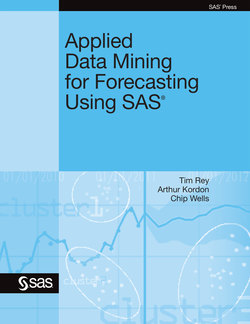Читать книгу Applied Data Mining for Forecasting Using SAS - Tim Rey - Страница 4
ОглавлениеContents
Chapter 1 Why Industry Needs Data Mining for Forecasting
1.2 Forecasting Capabilities as a Competitive Advantage
1.3 The Explosion of Available Time Series Data
1.4 Some Background on Forecasting
1.5 The Limitations of Classical Univariate Forecasting
1.6 What is a Time Series Database?
1.7 What is Data Mining for Forecasting?
1.8 Advantages of Integrating Data Mining and Forecasting
Chapter 2 Data Mining for Forecasting Work Process
2.3 Work Process with SAS Tools
2.3.1 Data Preparation Steps with SAS Tools
2.3.2 Variable Reduction and Selection Steps with SAS Tools
2.3.3 Forecasting Steps with SAS Tools
2.3.4 Model Deployment Steps with SAS Tools
2.3.5 Model Maintenance Steps with SAS Tools
2.3.6 Guidance for SAS Tool Selection Related to Data Mining in Forecasting
2.4 Work Process Integration in Six Sigma
2.4.3 Integration with the DMAIC Process
Chapter 3 Data Mining for Forecasting Infrastructure
3.2.1 Personal Computers Network Infrastructure
3.2.2 Client/Server Infrastructure
3.2.3 Cloud Computing Infrastructure
3.3.1 Data Collection Software
3.3.2 Data Preparation Software
3.3.5 Software Selection Criteria
3.4.1 Internal Data Infrastructure
3.4.2 External Data Infrastructure
3.5 Organizational Infrastructure
3.5.1 Developers Infrastructure
3.5.3 Work Process Implementation
Chapter 4 Issues with Data Mining for Forecasting Application
4.2 Technical Issues
4.2.1 Data Quality Issues
4.2.2 Data Mining Methods Limitations
4.2.3 Forecasting Methods Limitations
4.3 Nontechnical Issues
4.3.1 Managing Forecasting Expectations
4.3.2 Handling Politics of Forecasting
4.3.3 Avoiding Bad Practices
4.3.4 Forecasting Aphorisms
4.4 Checklist “Are We Ready?”
5.1 Introduction
5.2 System Structure and Data Identification
5.2.1 Mind-Mapping
5.2.2 System Structure Knowledge Acquisition
5.2.3 Data Structure Identification
5.3 Data Definition
5.3.1 Data Sources
5.3.2 Metadata
5.4 Data Extraction
5.4.1 Internal Data Extraction
5.4.2 External Data Extraction
5.5 Data Alignment
5.5.1 Data Alignment to a Business Structure
5.5.2 Data Alignment to Time
5.6 Data Collection Automation for Model Deployment
5.6.1 Differences between Data Collection for Model Development and Deployment
5.6.2 Data Collection Automation for Model Deployment
6.1 Overview
6.2 Transactional Data Versus Time Series Data
6.3 Matching Frequencies
6.3.1 Contracting
6.3.2 Expanding
6.4 Merging
6.5 Imputation
6.6 Outliers
6.7 Transformations
6.8 Summary
Chapter 7 A Practitioner's Guide of DMM Methods for Forecasting
7.1 Overview
7.2 Methods for Variable Reduction
Traditional Data Mining
Time Series Approach
7.3 Methods for Variable Selection
Traditional Data Mining
Example for Variable Selection
Variable Selection Based on Pearson Product-Moment Correlation Coefficient
Variable Selection Based on Stepwise Regression
Variable Selection Based on the SAS Enterprise Miner Variable Selection Node
Variable Selection Based on the SAS Enterprise Miner Partial Least Squares Node
Variable Selection Based on Decision Trees
Variable Selection Based on Genetic Programming
Comparison of Data Mining Variable Selection Results
7.4 Time Series Approach
7.5 Summary
Chapter 8 Model Building: ARMA Models
Introduction
8.1 ARMA Models
8.1.1 AR Models: Concepts and Application
8.1.2 Moving Average Models: Concepts and Application
8.1.3 Auto Regressive Moving Average (ARMA) Models
Appendix 1: Useful Technical Details
Appendix 2: The “I” in ARIMA
Chapter 9 Model Building: ARIMAX or Dynamic Regression Modes
Introduction
9.1 ARIMAX Concepts
9.2 ARIMAX Applications
Appendix: Prewhitening and Other Topics Associated with Interval-Valued Input Variables
Chapter 10 Model Building: Further Modeling Topics
Introduction
10.1 Creating Time Series Data and Data Hierarchies Using Accumulation and Aggregation Methods
Introduction
Creating Time Series Data Using Accumulation Methods
Creating Data Hierarchies Using Aggregation Methods
10.2 Statistical Forecast Reconciliation
10.3 Intermittent Demand
10.4 High-Frequency Data and Mixed-Frequency Forecasting
High-Frequency Data
Mixed-Interval Forecasting
10.5 Holdout Samples and Forecast Model Selection in Time Series
Introduction
10.6 Planning Versus Forecasting and Manual Overrides
10.7 Scenario-Based Forecasting
10.8 New Product Forecasting
Chapter 11 Model Building: Alternative Modeling Approaches
11.1 Nonlinear Forecasting Models
11.1.1 Nonlinear Modeling Features
11.1.2 Forecasting Models Based on Neural Networks
11.1.3 Forecasting Models Based on Support Vector Machines
11.1.4 Forecasting Models Based on Evolutionary Computation
11.2 More Modeling Alternatives
11.2.1 Multivariate Models
11.2.2 Unobserved Component Models (UCM)
Chapter 12 An Example of Data Mining for Forecasting
12.1 The Business Problem
12.2 The Charter
12.3 The Mind Map
12.4 Data Sources
12.5 Data Prep
12.6 Exploratory Analysis and Data Preprocessing
12.7 X Variable Imputation
12.8 Variable Reduction and Selection
12.9 Modeling
12.10 Summary
